Seven Impossible Interviews Before Breakfast #48:
Author/Illustrator G. Brian Karas
 October 10th, 2007 by jules
October 10th, 2007 by jules
 Back in May of this year, I decided that — instead of simply listing our seven kicks each week here at 7-Imp, a little tradition we began in March — we could feature an illustrator each Sunday as well (our 7-Imp art gallery, if you will, featuring the illustrators who have graced our site each Sunday thus far, is here). In mid-August, one of those illustrators who agreed to send us some art work was none other than author/illustrator G. Brian Karas, whose work we here at 7-Imp have adored over many years. To boot, he sent us a spread from Today and Today, an anthology of haiku by Kobayashi Issa, which Karas illustrated. It was released this March by Scholastic and reviewed here by Yours Truly (and the spread he sent was one I had specifically requested, as it is my favorite from the book, so . . . well, as a Southerner, I suppose I’m required to say bless his heart. Really, I was so grateful. You can see the spread below in the interview. It’s gorgeous).
Back in May of this year, I decided that — instead of simply listing our seven kicks each week here at 7-Imp, a little tradition we began in March — we could feature an illustrator each Sunday as well (our 7-Imp art gallery, if you will, featuring the illustrators who have graced our site each Sunday thus far, is here). In mid-August, one of those illustrators who agreed to send us some art work was none other than author/illustrator G. Brian Karas, whose work we here at 7-Imp have adored over many years. To boot, he sent us a spread from Today and Today, an anthology of haiku by Kobayashi Issa, which Karas illustrated. It was released this March by Scholastic and reviewed here by Yours Truly (and the spread he sent was one I had specifically requested, as it is my favorite from the book, so . . . well, as a Southerner, I suppose I’m required to say bless his heart. Really, I was so grateful. You can see the spread below in the interview. It’s gorgeous).
 If you haven’t experienced Today and Today yet, go treat yourself. Karas selected twenty-two of his favorite Issa poems to tell the story of a year in the life of a family — a year in which they will experience the loss of their beloved grandfather but also the renewal that comes from healing after loss. Dividing the entries into seasons, it’s a comforting and poignant look at life’s many cycles — and the little miracles in our day-to-day lives. Booklist wrote in their starred review, “Karas uses the haiku of the eighteenth-century Japanese poet Issa to limn a gentle, understated tale of one family over a year. The translations, from several different but fairly recent sources, do not always hew to the traditional syllabic format of haiku, but they are simply and clearly crafted . . . In a note, Karas explains that like Issa’s haiku, he tries to ‘convey the precise feeling of each moment.’ He succeeds beautifully.”
If you haven’t experienced Today and Today yet, go treat yourself. Karas selected twenty-two of his favorite Issa poems to tell the story of a year in the life of a family — a year in which they will experience the loss of their beloved grandfather but also the renewal that comes from healing after loss. Dividing the entries into seasons, it’s a comforting and poignant look at life’s many cycles — and the little miracles in our day-to-day lives. Booklist wrote in their starred review, “Karas uses the haiku of the eighteenth-century Japanese poet Issa to limn a gentle, understated tale of one family over a year. The translations, from several different but fairly recent sources, do not always hew to the traditional syllabic format of haiku, but they are simply and clearly crafted . . . In a note, Karas explains that like Issa’s haiku, he tries to ‘convey the precise feeling of each moment.’ He succeeds beautifully.”
So, after we featured his art work in mid-August at that kicks list, I was itchin’ to ask for an interview; I simply could not sign off without asking if he would be interested. I was a little bit intimidated, ’cause it’s G. Brian Karas. Extremely talented. Very prolific. Did I mention we’re fans? I’m very happy and relieved that he agreed to the interview.
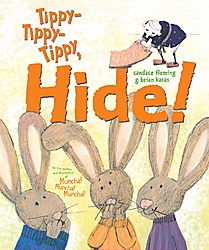
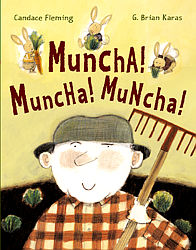 To be clear, Karas has released other picture book titles this year as well: How Many Seeds in a Pumpkin by Margaret McNamara, released by Schwartz & Wade Books in July (which I reviewed here), and Tippy-Tippy-Tippy, Hide! by Candace Fleming, published by Ginee Seo Books (Atheneum) in January — and which I also reviewed in my “The ‘G’ Stands for Ginormously Talented” post about Karas. The latter title is a sequel to 2002’s Muncha! Muncha! Muncha!, also by Candace Fleming, one of Karas’ most beloved and well-known illustrated titles — and one that epitomizes the spot-on comic timing of which he is capable.
To be clear, Karas has released other picture book titles this year as well: How Many Seeds in a Pumpkin by Margaret McNamara, released by Schwartz & Wade Books in July (which I reviewed here), and Tippy-Tippy-Tippy, Hide! by Candace Fleming, published by Ginee Seo Books (Atheneum) in January — and which I also reviewed in my “The ‘G’ Stands for Ginormously Talented” post about Karas. The latter title is a sequel to 2002’s Muncha! Muncha! Muncha!, also by Candace Fleming, one of Karas’ most beloved and well-known illustrated titles — and one that epitomizes the spot-on comic timing of which he is capable.
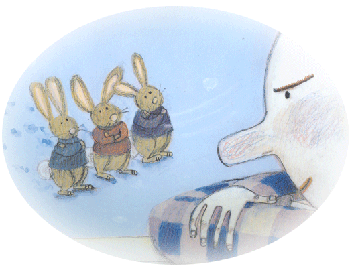 I try really hard, when featuring interviews with authors and illustrators, to include a proper introduction to their published titles, out of respect for them and their work — as opposed to just slapping up their interview responses without any sort of explanation as to what they’ve done and why I like them enough to interview them. But, hoo boy! Karas is a prolific illustrator. Go here, scroll down, and see for yourself. Perhaps — out of a bit of desperation, due to his fruitful and versatile (not to mention acclaimed) career — I will rely a bit on this bio below on the left, taken straight from his site:
I try really hard, when featuring interviews with authors and illustrators, to include a proper introduction to their published titles, out of respect for them and their work — as opposed to just slapping up their interview responses without any sort of explanation as to what they’ve done and why I like them enough to interview them. But, hoo boy! Karas is a prolific illustrator. Go here, scroll down, and see for yourself. Perhaps — out of a bit of desperation, due to his fruitful and versatile (not to mention acclaimed) career — I will rely a bit on this bio below on the left, taken straight from his site:
 Read it yet? That’ll do, huh? Really, the titles mentioned in this bio are fabulous ones you want to run and find if you have not yet read them, but in the interview below, I touch on many of his other titles as well. So, forgive me then for not having a huge annotated bibliography here, but if I did that, your eyes would cross (if you’re still eager for such information, go here to read that first award-laden paragraph). Suffice it to say that “the childlike style that belies the sophistication of {his} drawings,” as The New York Times put it there, is a large part of his charm — and always has been to me — over the years. As a librarian, I saw children swarm to his titles, and now I see my own young children do the same. His illustrations . . . well, I think they almost sparkle sometimes. They glimmer and gleam with a vibrancy — and humor, when it’s called for, as well as great feeling and wistfulness when that’s present in a text with which he’s working, too. You can spot Karas’ signature style as an illustrator from approximately one skerjillion miles away (to be precise), and the book which captures it is a). not likely to let you down and b). very likely to amuse and/or thrill and/or provide a bit of contemplation for the child(ren) with you, too. It’s almost too difficult to name my favorites — Saving Sweetness (by Diane Stanley; 1996; Putnam); Like Butter on Pancakes (by Jonathan London; 1995; Viking); The Seals on the Bus (by Lenny Hort; 2000; Henry Holt); Home on the Bayou: A Cowboy’s Story (Simon & Schuster; 1996). There are many to love.
Read it yet? That’ll do, huh? Really, the titles mentioned in this bio are fabulous ones you want to run and find if you have not yet read them, but in the interview below, I touch on many of his other titles as well. So, forgive me then for not having a huge annotated bibliography here, but if I did that, your eyes would cross (if you’re still eager for such information, go here to read that first award-laden paragraph). Suffice it to say that “the childlike style that belies the sophistication of {his} drawings,” as The New York Times put it there, is a large part of his charm — and always has been to me — over the years. As a librarian, I saw children swarm to his titles, and now I see my own young children do the same. His illustrations . . . well, I think they almost sparkle sometimes. They glimmer and gleam with a vibrancy — and humor, when it’s called for, as well as great feeling and wistfulness when that’s present in a text with which he’s working, too. You can spot Karas’ signature style as an illustrator from approximately one skerjillion miles away (to be precise), and the book which captures it is a). not likely to let you down and b). very likely to amuse and/or thrill and/or provide a bit of contemplation for the child(ren) with you, too. It’s almost too difficult to name my favorites — Saving Sweetness (by Diane Stanley; 1996; Putnam); Like Butter on Pancakes (by Jonathan London; 1995; Viking); The Seals on the Bus (by Lenny Hort; 2000; Henry Holt); Home on the Bayou: A Cowboy’s Story (Simon & Schuster; 1996). There are many to love.
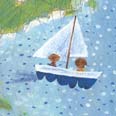

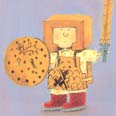 I’d like to thank Brian for taking the time in his busy schedule for this interview. Without further ado, here’s Mr. Karas . . .
I’d like to thank Brian for taking the time in his busy schedule for this interview. Without further ado, here’s Mr. Karas . . .
 Jules: How did the SCBWI Illustrators Intensive Workshop in February go? Do you enjoy teaching? What, if anything, do you consider the single most valuable piece of advice for an up-and-coming illustrator today?
Jules: How did the SCBWI Illustrators Intensive Workshop in February go? Do you enjoy teaching? What, if anything, do you consider the single most valuable piece of advice for an up-and-coming illustrator today?
Brian: The SCBWI workshop unfortunately coincided with a family crisis, and I felt somewhat removed from the conference. Despite that, the attendees worked hard and came up with some very creative solutions.
Advice — make the best work you can and believe in yourself. Can that count as a single piece of advice?
Jules: On that note, do you enjoy the school visits and workshops that you do? Do you feel a certain calling, if you will, to encourage children to create art, since you have said before that you didn’t take seriously the notion of being an artist until late into your senior year in high school when an art teacher encouraged and inspired you? Do you talk about your process as an illustrator when you visit schools?
Brian: I love school visits, but they’re demanding. I have two children of my own, and when I visit a school I feel like I have 500. But then I’ll remind myself that’s just one day’s work for me. I think teachers are super-beings.
I’m in the process of changing my school presentation, but it will probably take the same basic shape — I talk about what I do. I show how or where I get ideas (in a dream, stuck in traffic, mostly by paying attention to the world around me), why I make the choices I do (why I used a particular color or gave someone a really big nose), and why I love what I do (I get to draw ANYTHING I want. It could be something that no one else in the world likes or understands, but that doesn’t matter).
I enjoy workshops for the focused perspective I get from students of children’s book illustration. I spend very little time talking about my own work and open things up so the students can work on developing theirs. I love the exchange of ideas, and surprises.
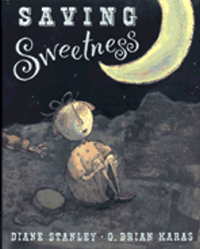 Jules: What exactly is your process when you are illustrating a book, particularly when it’s one you have written? You can start wherever you’d like when answering: getting the idea, starting to write/illustrate, or even what it’s like under deadline, etc. Do you outline a great deal of the book before you write/illustrate or just let your muse lead you on and see where you end up? (If you get asked this a lot, by chance, and are jaded with the question, feel free to promptly ignore it).
Jules: What exactly is your process when you are illustrating a book, particularly when it’s one you have written? You can start wherever you’d like when answering: getting the idea, starting to write/illustrate, or even what it’s like under deadline, etc. Do you outline a great deal of the book before you write/illustrate or just let your muse lead you on and see where you end up? (If you get asked this a lot, by chance, and are jaded with the question, feel free to promptly ignore it).
Brian: My starting point varies depending on whether I’ve written the story or not. My working process is kind of the same for both, though I really have to say it’s different for every book. When I’m working with another author’s story it all starts for me when I read the manuscript. It’s one of the most fun things I get to do. I usually have no idea what to expect, and as I’m reading I’m seeing pictures. It’s like going on a new ride every time. I try to give myself a lot of time to think about the story, months. I go to the places in the story (if that’s possible) and soak up everything I can. I surround myself with whatever inspires me — artwork, books, music. By the time I’m ready to start, I’ve got a good idea of where I want to go.
When I work on my own stories, it’s a quite different process. I like to start with nothing but an open and clear mind. I dig deep for ideas that mean the most to me, and hopefully to a child. The ideas can come from anywhere but have to come back to something that resonates for me; otherwise, it has no life.
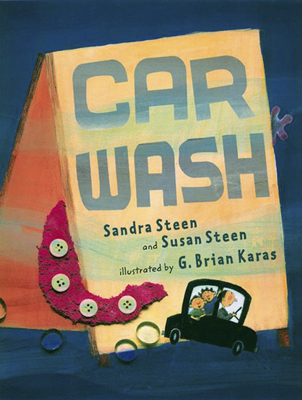 Jules: Do you have a medium in which you prefer to work? And will we see any more texturized collages out of you, your playing with “odds and ends” and household objects, such as with Car Wash by Sandra and Susan Steen and Odds ‘N’ Ends Alvy by John Frank?
Jules: Do you have a medium in which you prefer to work? And will we see any more texturized collages out of you, your playing with “odds and ends” and household objects, such as with Car Wash by Sandra and Susan Steen and Odds ‘N’ Ends Alvy by John Frank?
Brian: I like working with mixed media in a kind of haphazard but controlled way. I like my paint to work against the grain sometimes, a counterpoint to the surface I’m working on. Car Wash was fun — I took my young son to the crafts store and we filled the cart with everything that looked like it could live in the ocean.
Jules: As a lot of reviewers and your admirers have pointed out, there is a real child-centeredness to your illustrations, one of my favorite things about your work — and a lot of humor, as well. To what do you attribute that? Do you vividly recall the emotions and events of your childhood and try your best to translate that to children in your illustrations?
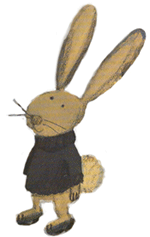 Brian: I think everyone feels attached to a certain childhood age, and mine is probably when I was picture book age. I don’t remember a large number of picture books that affected me, but the few that did left deep impressions. They were doorways, but not necessarily an escape. At that age, the whole world was as fantastic as places I read about. If it wasn’t, I could mold it into anything I wanted it to be, anything was possible. I think that’s what I try to tap into, especially when I’m writing my own stories — where those deep impressions came from and the idea that anything could be possible. And it’s got to be fun — what’s better than a really good laugh?
Brian: I think everyone feels attached to a certain childhood age, and mine is probably when I was picture book age. I don’t remember a large number of picture books that affected me, but the few that did left deep impressions. They were doorways, but not necessarily an escape. At that age, the whole world was as fantastic as places I read about. If it wasn’t, I could mold it into anything I wanted it to be, anything was possible. I think that’s what I try to tap into, especially when I’m writing my own stories — where those deep impressions came from and the idea that anything could be possible. And it’s got to be fun — what’s better than a really good laugh?
Jules: You have said before about creating children’s books: “Although at times it can be frustrating, slow, and always a challenge, I can think of no occupation more rewarding.” I think that your joy for illustrating shows in your work, but you also must find it rewarding, because you are amazingly prolific. In your impressive and lengthy career, have you consistently found it rewarding? What is the most challenging aspect of it? Do you still think we live in a “golden age for children’s books” (as you said in the ’05 SCBWI Bologna Conference interview)?
Brian: I’m not a historian, so I don’t know if they or publishers would agree with me about this being a golden age for children’s books. What I mean to say is that I find this to be a time of great creative freedom for children’s book artists. Technological gains allow artists to work in many types of media without being hindered by printing limitations. More open attitudes have made it easier to explore subject matter that was once forbidden. And the very nature of children’s books allows artists to be creative to the limits of their imaginations, much more so than in other areas of illustration.
Jules: I am in love with Today and Today. Can you tell us a bit more about the creation of that book? I think your affection for Issa’s poetry just shines through in your art work. Was it hard to say goodbye to that title upon its completion? And can you talk a little bit about the process of selecting and arranging the haiku you chose to tell the story you tell in the book?
Brian: It was suggested to me that I illustrate a book of haiku, which I hadn’t considered before. I began with my own haikus, but they were pretty bad. It became an anthology of other poets’ work, and when I realized most of the poems I liked were by Issa, I chose to work with his poems only. But I wanted more than a simple collection. I wanted the poems to say something as a whole. I struggled with creating a unifying element, and the idea of imposing a narrative that had nothing to do with the author’s intent. I liked the clarity of Issa’s expression and his unfiltered eye. His poems were very personal but they also seemed to come from many points of view, and I thought, if I could show what those poems could mean if told by different people, it could be like walking around sculpture — seen from a slightly different angle reveals more meaning. That’s when I thought to work with a family. A family has several voices but is one organism, and that idea didn’t seem to betray the poet’s intention.
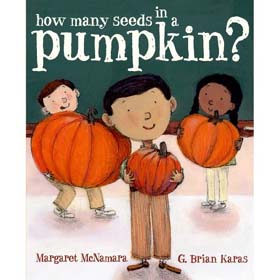 Jules: You have many titles
Jules: You have many titles
— such as, your newest (How Many Seeds in a Pumpkin? by Margaret McNamara), 7×9=Trouble by Claudia Mills, Ten Little Mummies by Philip Yates, and Elevator Magic by Stuart J. Murphy -– that are about math in one way or another. Are you a math lover and/or do you feel a particular need to make the subject more accessible to children through entertaining, illustrated titles?
Brian: I’m not a math-hater, but I wouldn’t call myself a math-lover. I like to put order to things, and that sometimes involves math. If I can help illuminate the world of numbers — or anything else for that matter — with my pictures, that’s enormously gratifying to me. Math is unavoidable in life, so why not make it fun and creative?
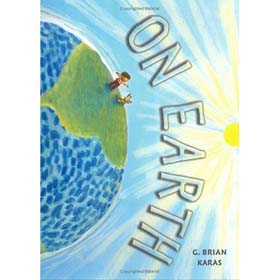 Jules: You also have a handful of titles -– such as, On Earth and Atlantic and even Today and Today -– which communicate a great reverence for Mother Nature and/or the need to take care of our planet. Is that something you consciously set out to write about?
Jules: You also have a handful of titles -– such as, On Earth and Atlantic and even Today and Today -– which communicate a great reverence for Mother Nature and/or the need to take care of our planet. Is that something you consciously set out to write about?
Brian: Yes. I think people become more removed from the natural world as technology and lifestyles evolve, and I think that’s a great loss. My interest in nature as a subject is not only out of concern for preservation but understanding our place in nature. One reader said of On Earth, “…The notion that we are all ‘passengers of the earth’ together
reinforces our human interdependence and need for multicultural awareness.”
 Jules: Your illustrations for the picture book adaptations of folk and fairy tales and folk songs -– such as, The Seals on the Bus by Lenny Hort; I Know an Old Lady; Cinder-Elly and Sleepless Beauty by Frances Minters; and even Throw Your Tooth on the Roof by Selby B. Beeler -– are distinctive in style. Is it challenging to pull that off, since they are such time-honored stories and tales?
Jules: Your illustrations for the picture book adaptations of folk and fairy tales and folk songs -– such as, The Seals on the Bus by Lenny Hort; I Know an Old Lady; Cinder-Elly and Sleepless Beauty by Frances Minters; and even Throw Your Tooth on the Roof by Selby B. Beeler -– are distinctive in style. Is it challenging to pull that off, since they are such time-honored stories and tales?
Brian: I’m a little off the hook as the illustrator if an author has done the retelling. The author has the onus of bringing new life and meaning to favorite tales, but I think the illustrator also has the responsibility of catching our eye in a new way. I’m in the middle of retelling a well-known myth, and I definitely feel the weight of all its previous incarnations, but I’m also having a lot of fun.
Jules: Tell us about your decision -– for the first time and after years of illustrating others’ texts -– 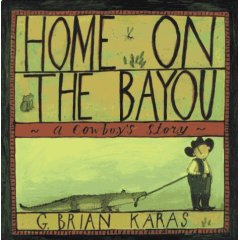 to both write and illustrate your own book (Home on the Bayou: A Cowboy’s Story, 1996). And how gratifying was it for you to have your first authored/illustrated text be awarded a Boston Globe/Horn Book Honor?
to both write and illustrate your own book (Home on the Bayou: A Cowboy’s Story, 1996). And how gratifying was it for you to have your first authored/illustrated text be awarded a Boston Globe/Horn Book Honor?
Brian: I’ve been writing for as long as I’ve been drawing. The two were always like one in my mind, though I think I must have always felt more comfortable expressing myself visually. In art school when I began to focus on and create children’s book art, the interest in writing was there as well. It took years to sell a story after beginning to think I might never sell anything. I was, and am, most proud of that award.
 Jules: How different is the process of illustrating a beginning reader –- such as, Cynthia Rylant’s High-Rise Private Eyes series — from the process of illustrating another’s picture book text? And, on the subject of illustrating others’ texts, do you have a say in whose words you get to bring to life with your art? Can you describe the elements of a text that would make you really want to illustrate it, that would really get your creative juices flowing?
Jules: How different is the process of illustrating a beginning reader –- such as, Cynthia Rylant’s High-Rise Private Eyes series — from the process of illustrating another’s picture book text? And, on the subject of illustrating others’ texts, do you have a say in whose words you get to bring to life with your art? Can you describe the elements of a text that would make you really want to illustrate it, that would really get your creative juices flowing?
Brian: That’s a good question. The process of illustrating for beginning readers is different from picture book art, at least for me. Beginning readers are designed for the new reader who wants to feel they’ve read a story without need of illustrations. The pictures are there to reinforce what was just read.
When I read a manuscript there are alot of things that could appeal to me as an illustrator — good characters, interesting story and setting, though humor and originality really get my attention. All those things are important, but the story has to tug at my heart in some way or I find it hard to get close enough.
Jules: I read that you have worked in many interesting studios, including “a sewing factory-turned artists co-op in New York City, a sculptor’s loft on Seattle’s waterfront, a Frank Lloyd Wright house in the desert, and a small cottage on the grounds of an old lodge on Camelback Mountain in Phoenix.” Wow. Was there one most-conducive-to-creating-art space? And what, generally, do you need your work space to be when you create? Do you listen to music while you create, or does it hinder you? Did you actually do sculpture in that sculptor’s loft, despite your traumatic Kindergarten setback when trying to create that three-dimensional tipi?
Brian: The Frank Lloyd Wright house may have been the most aesthetically interesting building to work in, but the most inspiring space for me was the El Oeste Lodge on Camelback Mountain. It was a peaceful desert oasis in the middle of Phoenix, lovingly looked after by the owner, MJ. She respected my need for privacy but would let me know when the baby quail were running around or a cactus had bloomed, because she knew I’d want to see.
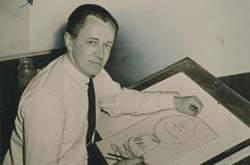 Jules: I know this is a cliché question, but as a book lover, it interests me: What books or authors and/or illustrators influenced you as an early reader? You have mentioned in previous interviews your love for Charles Schulz’s work. Do you have an opinion about the so-called “graphic novel trend” in children’s lit that is so talked-up these days? It seems to get labeled a trend, though graphically-sequenced books and comics for children have been around a long time. Are you, as a Schulz fan, happy that comics and “graphic novels” suddenly have this huge spotlight on them?
Jules: I know this is a cliché question, but as a book lover, it interests me: What books or authors and/or illustrators influenced you as an early reader? You have mentioned in previous interviews your love for Charles Schulz’s work. Do you have an opinion about the so-called “graphic novel trend” in children’s lit that is so talked-up these days? It seems to get labeled a trend, though graphically-sequenced books and comics for children have been around a long time. Are you, as a Schulz fan, happy that comics and “graphic novels” suddenly have this huge spotlight on them?
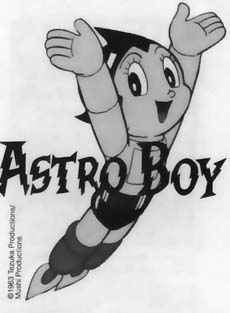 Brian: I mentioned earlier I can only remember a few books from childhood, most notable is The Story of Babar. I also read a lot of comics and loved cartoons. I was a big fan of Astroboy, Rocky and Bullwinkle, and — when I was a little older — Peanuts. I didn’t necessarily make the distinction then between books, comics, or even TV. I don’t know about the crossing over of comics into children’s literature being a trend, but it seems to be more prevalent and I’m glad to see it. It’s a slightly different way of telling a story and in some ways can be more expressive than other more traditional structures. I also like how the format allows artists to break the picture plane in different ways. The words and pictures become more integrated and like one.
Brian: I mentioned earlier I can only remember a few books from childhood, most notable is The Story of Babar. I also read a lot of comics and loved cartoons. I was a big fan of Astroboy, Rocky and Bullwinkle, and — when I was a little older — Peanuts. I didn’t necessarily make the distinction then between books, comics, or even TV. I don’t know about the crossing over of comics into children’s literature being a trend, but it seems to be more prevalent and I’m glad to see it. It’s a slightly different way of telling a story and in some ways can be more expressive than other more traditional structures. I also like how the format allows artists to break the picture plane in different ways. The words and pictures become more integrated and like one.
Jules: Can you tell us about any new titles/projects you might be working on now?
Brian: I’m retelling a Greek myth at the moment, but that’s all I want to say about it. I’m superstitious.
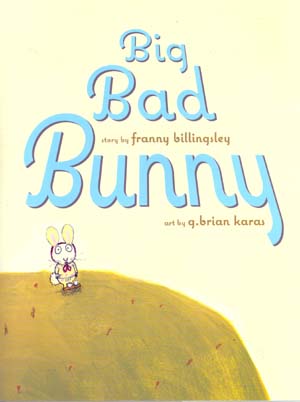 Jules: {Ed. Note: As mentioned in our mid-August Sunday feature of Today and Today, Brian’s next illustrated book is entitled Big Bad Bunny (a Richard Jackson book for Atheneum Books), written by Franny Billingsley, author of The Folk Keeper. Big Bad Bunny will be published in ’08}.
Jules: {Ed. Note: As mentioned in our mid-August Sunday feature of Today and Today, Brian’s next illustrated book is entitled Big Bad Bunny (a Richard Jackson book for Atheneum Books), written by Franny Billingsley, author of The Folk Keeper. Big Bad Bunny will be published in ’08}.
Jules: What’s one thing that most people don’t know about you?
Brian: I’m a map geek. I love them.
Jules: What, if any, impossible things do you do before breakfast?
Brian: I don’t eat breakfast so can’t answer that, but my morning routine includes practicing tai chi and doing the crossword puzzle. Sometimes that’s impossible.
Jules: If you could have three (living) illustrators or author/illustrators — whom you have not yet met — over for coffee or a glass of rich, red wine, whom would you choose? If you think that question is entirely too unfair, I give you permission to scold me and/or ignore it.
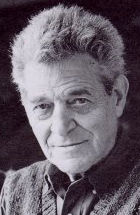 Brian: Since this is an imaginary get-together, may I invite the living and deceased? William Steig, James Marshall, and M. B. Goffstein would be at the top of the guest list.
Brian: Since this is an imaginary get-together, may I invite the living and deceased? William Steig, James Marshall, and M. B. Goffstein would be at the top of the guest list.
Jules: Is there something you wish interviewers would ask you — but never do? Feel free to ask and respond here.
Brian: You’ve covered everything I can think of, and more!
Jules: We like to ask people the wonderfully weird set of questions called The Pivot Questionnaire, since who knew that, say, asking someone what their favorite sound or noise is could tell you so much about them. So here goes:
What is your favorite word?
Brian: “But.”
Jules: What is your least favorite word?
Brian: “Must.”
Jules: What turns you on creatively, spiritually or emotionally?
Brian: Looking at stars or clouds, listening to the ocean or wind. It’s not only restorative but inspiring to me.
Jules: What turns you off?
Brian: Negativity.
Jules: What is your favorite curse word? (optional)
Brian: “Crap.” I have other favorites when I’m with my friends.
Jules: What sound or noise do you love?
Brian: Kids laughing.
Jules: What sound or noise do you hate?
Brian: Whining.
Jules: What profession other than your own would you like to attempt?
Brian: Professional ski and or beach bum.
Jules: What profession would you not like to do?
Brian: Sanitation. I have a keen sense of smell.
Jules: If Heaven exists, what would you like to hear God say when you arrive at the Pearly Gates?
Brian: “Come on in, all your friends and loved ones are here, and everything you ever lost.”
For more information on G. Brian Karas:
- Karas’ web site.
- Interview for SCBWI Bologna Conference, “Words across Pictures and Picturing Words,” at Karas’ site; April 12, 2005.
- “Children’s Author/Illustrator Biographies: Karas, G. Brian” at the Educational Paperback Association; 2000.
- Write-up at Penguin Group; 2000.
- Excerpt from Talking With Artists, Vol. 3, compiled and edited by Pat Cummings; portions are available online at Google Book Search; 1992.
- Feature at Embracing the Child; Undated.
- “About the Illustrator, G. Brian Karas” at the Texas State Library and Archives Commission’s Resources for Librarians (“Mission Possible: Spy A Book!”); Undated.
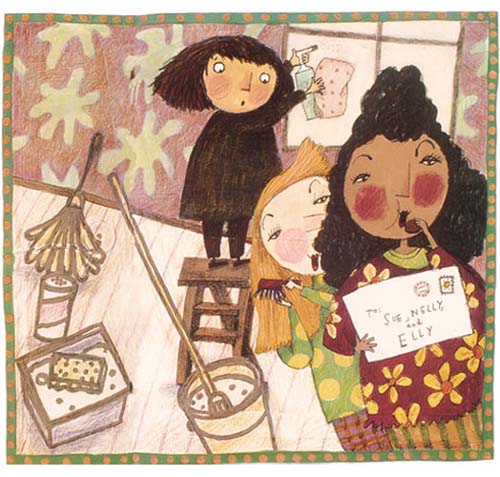

Jules,
This was GREAT! Karas is one of my favorite picture book illustrators. I love “today & today.” It’s such a tender and touching book of poetry and art. It’s truly a special book for children–and forpeople like me who are crazy about poetry.
I really enjoy the humor that is characteristic of Karas’s art, too.
I love his answer to the last question. I’m even imagining how it could be a story premise…how everything you’ve ever lost comes back to you…
And I’m so excited that Franny Billingsley has a picture book coming out with Brian. I loved The Folk Keeper.
Hey, when are you going to collect these interviews into a book?
Thanks, guys.
Elaine, I think Today and Today is really special, too (quite obviously).
Sara, I love his last response, too. And, hey, a book?! Tempting idea. Never crossed my mind.
I have always wanted to read The Folk Keeper, Sara. See why I don’t do other things like knit or garden? Too many books to read. Not enough time.
Hi Guys,
What a great interview. I love Brian Karas. I never realized so much of his work graced my shelves. I guess that’s what happens when you shelve by subject!
Thanks for sharing.
Tricia
Tricia, I feel like a traitor to writers for saying this, but sometimes I wish picture books were shelved by illustrator.
jules,
thanks for one of the most comprehensive, in-depth interviews ever! loved getting into the mind of such a genius!
I’d like to believe that I’d be reunited with everything I’d ever lost, too.
Another wonderful interview, ladies!
That was an amazing and insightful interview. On a similar note sort of Candace Flemming will be doing an author visit at Mount Prospect Public Library in Mount Prospect, IL Monday Oct. 29th if anyone’s interested in seeing her 🙂
This is my favorite interview today… and today 🙂
Really, guys. This is awesome. I’m going to read Butter on Pancakes now. And maybe that’s what we’ll have for dinner…
Wow! Great interview and images! Jim and I met Brian at a SCBWI conf in Seattle a few years ago and he could not have been nicer. And eesh, so talented! And so prolific! I haven’t seen Today & Today yet — it looks wonderful 🙂
I love that his favorite word is “but” and his least favorite word is “must.” I get that.
Nice job, Jules. This interview turned out fabulous. I’m so glad you had the gumption to ask him.
How Many Seeds in a Pumpkin? JUST came into my store today. Great timing. Great interview.
Happy birthday to your munchkin, Jules!
Brian is freaking awesome! What a wonderful interview. I forgot to ask him (but have always wondered) about his work on the beginning readers and am so glad you did.
[…] This is going to be brief, as I seem to have been visited this week by the same bug my daughters had within the past couple of weeks. But I wanted to check in—an early Poetry Friday post, if you will—with some art from one of my favorite illustrators, G. Brian Karas. […]
Jules, thank you for the update and this 2007 interview with Karas. About a year ago, I was visiting the good people at Candlewick Press and they showed me sketches for a poetry book G. Brian Karas was working on. I was struck (silly me!) by how well-designed, rigorous and clear they were. I’d always thought of his work as “inspired” and very informal. It is, but it is so much more: it is professional, well-considered and I’m sure, a balm and delight to a harried book designer or editor.
[…] This is going to be brief, as I seem to have been visited this week by the same bug my daughters had within the past couple of weeks. But I wanted to check in—an early Poetry Friday post, if you will—with some art from one of my favorite illustrators, G. Brian Karas. […]
[…] historical picture books, novels, and picture books), and illustrator G. Brian Karas, who is—as I’ve already made clear—a long-time favorite illustrator of mine. And the book really—you knew this was […]
curious about your comment about El Oeste. How can I find out more about this place? The internet is devoid of anything at all, which probably is a good thing. How can I reach them. What is the place about?
[…] you missed last week’s column, I weighed in on Norton Juster’s Neville, illustrated by G. Brian Karas. I’ve got some preliminary drawings/materials from that here this morning, thanks to Karas. […]
[…] I reviewed Elizabeth Bluemle’s Tap Tap Boom Boom (Candlewick, March 2014), illustrated by G. Brian Karas, for BookPage. What a good book it is, and that review is here over at the wonderful BookPage […]
[…] I don’t imagine non-artists can truly appreciate to the same degree as another illustrator would. Brian Karas is a quiet genius. Ditto Ana Juan; Frida is a fantastic. I love Raúl Colón, Marla Frazee, and Jon […]
[…] Author/Illustrator website Author/Illustrator interview: Seven Impossible Things Before Breakfast Author/Illustrator biography: Google Books Time lapse of an acorn sprouting: […]
[…] Illustrator website Illustrator interview: Seven Impossible Things Before Breakfast Illustrator biography: Google […]